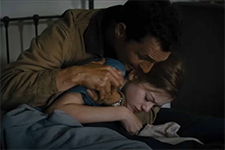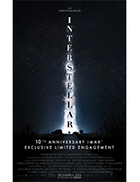Interstellar (4K UHD)
|  Christopher Nolan’s Interstellar is nothing if not grandly ambitious, and while that ambition is certainly admirable, especially in an industry that is choking even more than ever on interchangeable big-budget franchises and starving for original ideas, it is also part of the film’s downfall. Interstellar is not a bad film; in fact, it is a pretty good one, but at virtually every turn you can sense Nolan straining, stretching, reaching for something bigger, grander, more profound, and more emotional than what he had achieved in his previous films, and that sense of effort weighs it down. Nolan had done some of his best work on a more scaled-down register—think about the three-character morality play at work in Memento (2001), still his greatest film, or even the limited urban setting of The Dark Knight (2008), the one film in his Batman trilogy that doesn’t include far-flung locations around the world—and it is tempting to wonder if maybe he should have scaled back for a while, rather than ramped up, especially after the grandiosity of Inception (2010). Nolan is that rare Hollywood talent who can merge the epic and the emotional, but in Interstellar he gives us too much of virtually everything. The film begins on Earth in an unspecified near future where the human race is facing some kind of ecological catastrophe that is killing crops (and animals, too, since I don’t recall seeing any in the film) and turning the world into a giant dust bowl. Nolan, who co-wrote the screenplay with his brother Jonathan, wisely eschews the typical apocalyptic movie set-up by eliminating the informative crawl or the dour voice-over narration informing us of what has gone wrong and instead allows us to piece together the situation as the story unfolds. In the end, we don’t really need to know why the world is in a state of dust-blown ecological collapse, only that it is and the only hope for saving humanity is to find a way to get people off the Earth and colonize another planet. We are introduced to the film’s protagonist, a farmer named Cooper (Matthew McConaughey), in the midst of a nightmare about a suborbital training flight, thus establishing his past life as a NASA pilot, an occupation that doesn’t have much use in a world where growing enough food is the only activity worth pursuing. Coop, as almost everyone calls him, is a widower and father of two, a 15-year-old boy named Tom (Timothée Chalamet in an early role) and a 10-year-old girl named Murph (Mackenzie Foy), the latter of whom has inherited her father’s intense love of science and exploration. They live on a dusty farm with Coop’s aging father-in-law (John Lithgow) growing corn, which is apparently the only crop that will still flourish. As the film opens, something strange is happening in Murph’s bedroom: Books are falling off her shelf, propelled by an unseen force, which she attributes to a ghost and Coop generally ignores—that is, until it becomes clear that these falling books are sending a message that leads him to an underground bunker where the remnants of NASA, led by Professor Brand (Michael Caine) and his daughter Amelia (Anne Hathaway), are working feverishly to save the human race. Dubbed “The Lazarus Project,” they have taken advantage of a mysterious wormhole that has opened up near Saturn to send 12 astronauts to 12 different planets in another galaxy that may or may not be able to sustain human life. Coop is tasked with piloting a follow-up mission to check up on these intrepid explorers, who have been gone for years and have been sending back data regarding the planets on which they landed. The second half of the film consists of that journey and the attendant dangers, mistakes, and interpersonal conflicts that make it such a perilous venture. Coop and Amelia are joined by a small crew (including characters played by Wes Bentley and David Gyasi), as well as an artificial intelligence robot named TARS (voiced by Bill Irwin). The gritty, Depression-era despondency of the film’s opening act is not left completely behind, as Coop and the others are able to receive message from their loved ones back on Earth, including Murph, who was and still is angry at her father for leaving her behind. The journey was already going to be years in the making, but time spent on a planet where each hour equals seven years of Earth time creates a significant rift in their aging, with Coop remaining basically the same age while his children (now played by Jessica Chastain and Casey Affleck) have become adults, forging their way through a life on Earth that is becoming less and less survivable and always unknowing as to where their father is and if he will ever come home. Interstellar’s obvious touchstone is Stanley Kubrick’s 2001: A Space Odyssey (1968), the great metaphysical epic that imbued the science fiction genre on screen with a sense of gravitas and philosophical weight that it had previously lacked, especially given the preponderance of schlocky sci-fi monster shows and silly space exploration yarns that had populated screens throughout the Eisenhower era. You can sense Nolan trying to do something similar in wrestling science fiction back from the explosion of comic book franchises that his Batman Begins (2005) helped initiate (although, it should be noted, his Batman films are resolutely realistic in intent), and he goes about it by weighing the film down with seemingly endless scientific explanation about time paradoxes, wormholes, relativity, and the like. This is where he and Kubrick diverge: Watch 2001, and you will notice very little discussion of the science that Kubrick and Arthur C. Clarke so studiously researched and employed. Rather, they built it into the story and the production design and left it without comment. Nolan, who worked closely with theoretical physicist Kip Thorne in conjuring the film’s scientific details, can’t leave it alone and wants to make sure we know how much effort went into the film’s science, speculative or otherwise. And that is something of a problem for a film that ultimately wants to be a tear-jerking father-daughter melodrama. Nolan banks heavily on the relationship between Coop and Brand, positing them as mirror images of each other and filial soul mates (which, unfortunately, gives poor Tom, as both a teenager and an adult, short shrift). Nolan doesn’t want to delve into any kind of Oedipal ickiness, so the bond between father and daughter is presented as pure and heartfelt, with Coop and Murph bonding over their mutual love of science and the thrill of discovery. The problem is that the connection never fully takes hold, and once Coop is jetted through the wormhole, their connection becomes an abstraction that simply doesn’t hold the emotional weight Nolan ascribes to it (although Hans Zimmer’s at times bombastic score certainly tries to meld the epic and the intimate). To make up for this disjunction, he loads his characters, particularly Brand, with heavy monologues about the power and transcendence of love and brings the film to a climax inside the wormhole, which allows Coop the fantasy-turned-nightmare of being able to re-experience the moment when he left Murph without being able to change it. Interstellar is really a love story, but its emotional resonance never comes close to matching, much less fully aligning, with its otherworldly ambitions, resulting in a film that feels fractured at its core. There are moments of extreme beauty and awe, and Nolan orchestrates the wonderment of space exploration with the same beautiful gravitas that Kubrick gave to his spinning space station. But, unlike Kubrick, Nolan can’t settle on a singular vision, instead trying to have it multiple ways and never quite reconciling all his various ambitions.
Copyright © 2024 James Kendrick Thoughts? E-mail James Kendrick All images copyright © Paramount Home Entertainment | |||||||||||||||||||||||||||||
Overall Rating: 

 (3)
(3)



